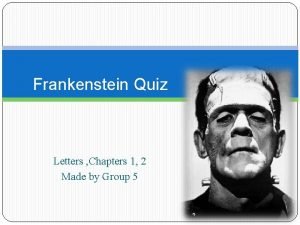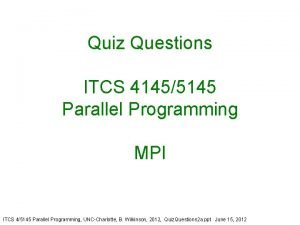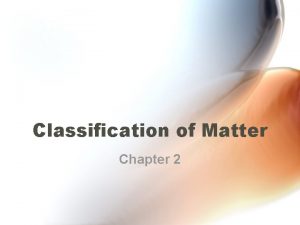Chapter 9 Classification of Matter Element Quizzes and











- Slides: 11

Chapter 9 Classification of Matter


Element Quizzes and Test Schedule Quiz #1 – Dec. 1 st Quiz #2 – Dec. 3 rd Quiz #3 – Dec. 8 th Quiz #4 – Dec. 10 th Quiz #5 – Dec. 15 th TEST ON ALL 75 – TBA

9 -1 Composition of Matter • Elements - a pure substance; matter in which all the atoms are alike. – Examples: • Carbon – pencil lead ( graphite ); diamonds; coal • Copper – pennies ( solid before 1982 ), pipes • Chlorine – to purify water, gas ( toxic ) – There are more than 110 elements; 92 are natural • Compound - made of two or more elements/atoms chemically combined. – Examples: • Water: H 2 O, Carbon dioxide: CO 2, Sodium chloride: Na. Cl

9 -1 Composition of Matter Substance – can be an element or a compound but it cannot be broken apart by physical means and it can only be split by a chemical reaction. Mixture – made of two or more substances that are NOT chemically combined so they can be separated by physical processes (heating, sifting, settling) They are not always in the same ratio or % composition. Examples: concrete, flavored grits, tea, Kool-Aid, soft drinks, blood, air, dry soup mixture, soup, fruit cocktail, instant cocoa.

Types of Mixtures – Homogeneous mixtures – substances are evenly spread out; also known as SOLUTIONS. Ex – Kool-Aid, tea, vinegar, syrup, soft drinks. – Heterogeneous mixtures – different materials can be distinguished. Ex – vegetable soup, fruit cocktail, concrete, grits. – Colloid – a heterogeneous mixture that “never settles”. Ex – milk, gelatin “Jello”, fog, smoke, whipped cream – Suspension – heterogeneous mixture in which visible particles “settle” in the liquid. Ex – muddy water, Italian dressing, liquid butter, some medicines.

9 -2 Smog – Environmental Mixture Smog ( smoke+fog) is a form of air pollution; is a colloid of small invisible pieces of solid materials mixed with gases in the air. It is made of dust such as soil, ash from volcanic eruptions, soot from coal and auto exhausts, from industries and forest fires. The solid particles will mix with the moisture in the air (fog) to form the smog. When light hits the dust and water droplets in the air it is scattered and creates the “Tyndall effect”, causing a hazy appearance in the atmosphere.


9 -3 Describing Matter • Physical Properties – characteristics that you can observe without changing the substances that make up the material. Ex: size, shape, color, state, length, temperature, odor, magnetism, density, melting / boiling point. • Physical change – a change that does not change the identity of the substance, just changes in the physical properties.

Describing Matter ( cont. ) • Chemical Properties – characteristics of a substance that indicate if it can undergo a certain change; whether it is flammable, combustible, if it will rust, or if it is toxic. • Chemical Change – a change of one substance to a different substance. It is usually indicated by various signs such as odors, foaming, explosions, and color changes.

Describing Matter • The Law of Conservation of Mass – The mass of all substances present before a chemical reaction equals the mass of the substances remaining after the chemical reaction. • Matter can not be created or destroyed, it simply changes from one form to another. – If you measure the mass of a log before burning, and could capture all the smoke, gases, ashes, and soot when the log burns, they would have the same mass as the log before burning. – This is true for any substance that changes form.
 Classification of matter section 1 composition of matter
Classification of matter section 1 composition of matter Composition of matter section 1
Composition of matter section 1 Section 1 composition of matter chapter 15 answer key
Section 1 composition of matter chapter 15 answer key Frankenstein chapter 1-5 quiz
Frankenstein chapter 1-5 quiz Chapter 2 matter section 1 classifying matter answer key
Chapter 2 matter section 1 classifying matter answer key Function of grey matter and white matter
Function of grey matter and white matter Gyrus and sulcus function
Gyrus and sulcus function Gray matter and white matter
Gray matter and white matter White matter vs grey matter
White matter vs grey matter Distinguish between a signal element and a data element.
Distinguish between a signal element and a data element. Jlab quizzes
Jlab quizzes Mpi quizzes
Mpi quizzes





















